
The sergeant major or píntano is a species of damselfish. It grows to a maximum length of about 22.9 centimetres (9.0 in).

Thalassoma bifasciatum, the bluehead, bluehead wrasse or blue-headed wrasse, is a species of marine ray-finned fish, a wrasse from the family Labridae. It is native to the coral reefs of the tropical waters of the western Atlantic Ocean. Individuals are small and rarely live longer than two years. They form large schools over the reef and are important cleaner fish in the reefs they inhabit.

The ballan wrasse is a species of marine ray finned fish from the family Labridae, the wrasses. It is found in the eastern Atlantic Ocean, where it inhabits rocky areas. Like many wrasse species, it is a protogynous hermaphrodite—all fish start life as females, and some dominant fish later become males. It is used as a food fish in some areas and it is also finding use as a cleaner fish in the aquaculture of Atlantic salmon in northwestern Europe.

The moon wrasse also known as the crescent wrasse or lyretail wrasse, is a species of wrasse native to the Indian Ocean and the western Pacific Ocean. It is an inhabitant of coral reefs and surrounding areas at depths from 1 to 20 m. Moon wrasses are carnivorous and tend to prey on fish eggs and small sea-floor dwelling invertebrates. This species can reach 45 cm (18 in) in total length. It is of minor importance to local commercial fisheries and can also be found in the aquarium trade.

The checkerboard wrasse is a fish belonging to the wrasse family. It is native to the area including the Indian Ocean to central Pacific Ocean.

Plectropomus laevis, known commonly as the black-saddled coral grouper, cluespotted coral trout, blacksaddled coral trout, blue-spot trout, Chinese footballer, footballer cod, footballer coral trout, oceanic coral trout or tiger trout, is a species of marine ray-finned fish, a grouper from the subfamily Epinephelinae which is part of the family Serranidae, which also includes the anthias and sea basses. It is found in the Indo-Pacific region.
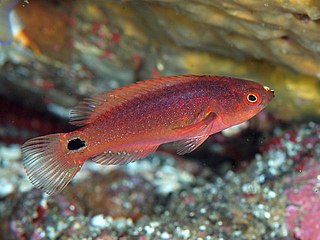
The exquisite wrasse is a species of ray-finned fish from the family Labridae, the wrasses, which is native to reefs in the Indo-West Pacific region. It can be found in the aquarium trade.

Jansen's wrasse is a species of ray-finned fish, a wrasse from the family Labridae which is native to the Indian Ocean and Pacific Ocean. In the south-western Pacific Ocean it is replaced by sibling species black-barred wrasse. It can be found in the aquarium trade.

The striated wrasse, also known as the disappearing wrasse, pinstripe wrasse or scarlet wrasse, is a species of marine ray-finned fish from the family Labridae, the wrasses. It has a wide Indo-Pacific distribution. This species can also be found in the aquarium trade.

The inscribed wrasse is a species of marine ray-finned fish from the family Labridae, the wrasses. It is found in the southwestern Pacific Ocean.

The sixbar wrasse or six-banded wrasse is a species of wrasse in the family Labridae, native to the Indian Ocean and the western Pacific Ocean. It is an inhabitant of reef environments at depths from the surface down to 15 m (50 ft). This species can grow to 20 cm (8 in) in total length, though most individuals do not exceed 15 cm (6 in). It is of minor importance to local commercial fisheries and can also be found in the aquarium trade.

The ornate wrasse is a species of wrasse native to the rocky coasts of the eastern Atlantic Ocean and the Mediterranean Sea. This species is of minor importance to local commercial fisheries, is also popular as a game fish, and can be found in the aquarium trade.
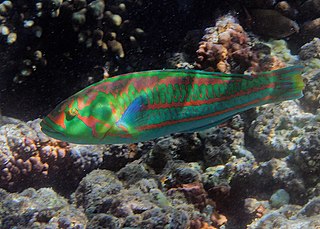
The surge wrasse, also known as the green-blocked wrasse, purple wrasse or red and green wrasse, is a species of wrasse native to the southeast Atlantic Ocean through the Indian and Pacific Oceans, where it inhabits reefs and rocky coastlines in areas of heavy wave action at depths from the surface to 10 m (33 ft). This species is of minor importance to local commercial fisheries, is popular as a game fish, and can be found in the aquarium trade.
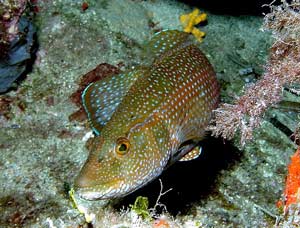
Labrus viridis is a species of wrasse native to the eastern Atlantic Ocean from Portugal to Morocco, as well as through the Mediterranean Sea to the Black Sea. This species is found around rocky reefs amongst the rocks or in eelgrass beds. It can reach 47 cm (19 in) in standard length, though most do not exceed 37.5 cm (15 in). It is one of several species called green wrasse.

Hologymnosus annulatus, the ring wrasse or ringed slender wrasse, is a species of marine ray-finned fish from the family Labridae, the wrasses, which has a wide Indo-Pacific distribution.
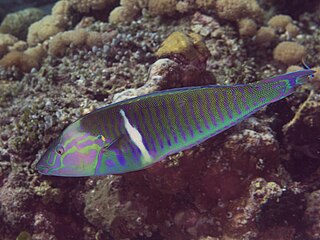
Hologymnosus doliatus, commonly called Pastel ringwrasse , is a marine ray-finned fish belonging to the family Labridae, the wrasses, which is found in the Indo-Pacific area.
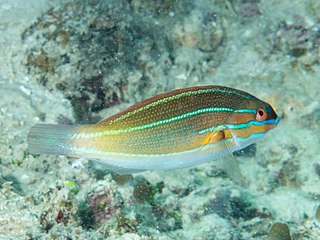
Stethojulis trilineata, also known as the blue-ribbon wrasse, red shouldered rainbow-fish, scarlet-banded rainbowfish, three-blueline wrasse, three-lined rainbowfish or three-lined wrasse, is a species of marine ray-finned fish, a wrasse from the family Labridae. It is found in the Indo-Pacific region where it is associated with reefs.
Hologymnosus longipes, the sidespot longface wrasse or the plain slender wrasse, is a species of marine ray-finned fish from the family Labridae, the wrasses. It occurs in the western Pacific Ocean.
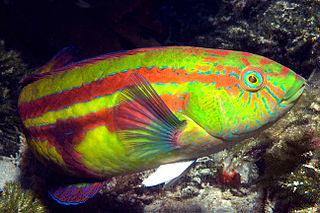
Pictilabrus laticlavius, the patrician wrasse, the senator wrasse, the green parrotfish or the purplebanded wrasse is a species of marine ray-finned fish from the family Labridae, the wrasses. It is found in the eastern Indian Ocean and the south western Pacific Oceans off the temperate coasts of southern Australia.

Pseudocoris heteroptera, the torpedo wrasse or zebra wrasse, is a species of marine ray-finned fish, a wrasse from the family Labridae. It is found in the western Pacific Ocean where it is associated with reefs.



















